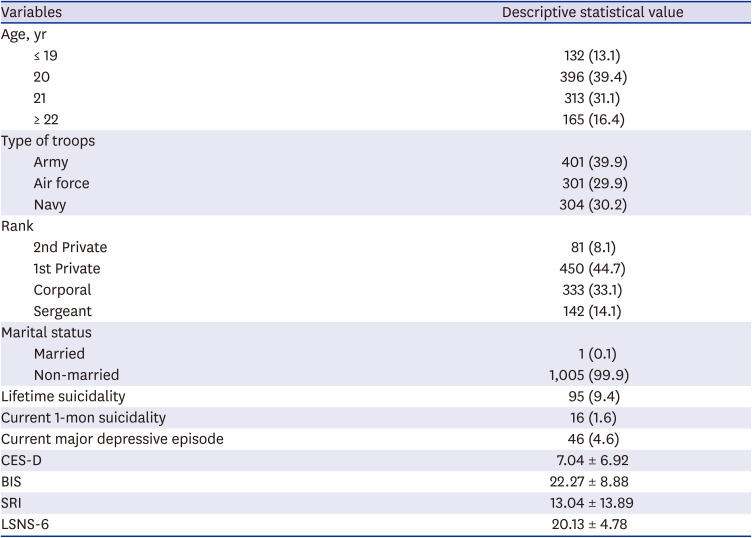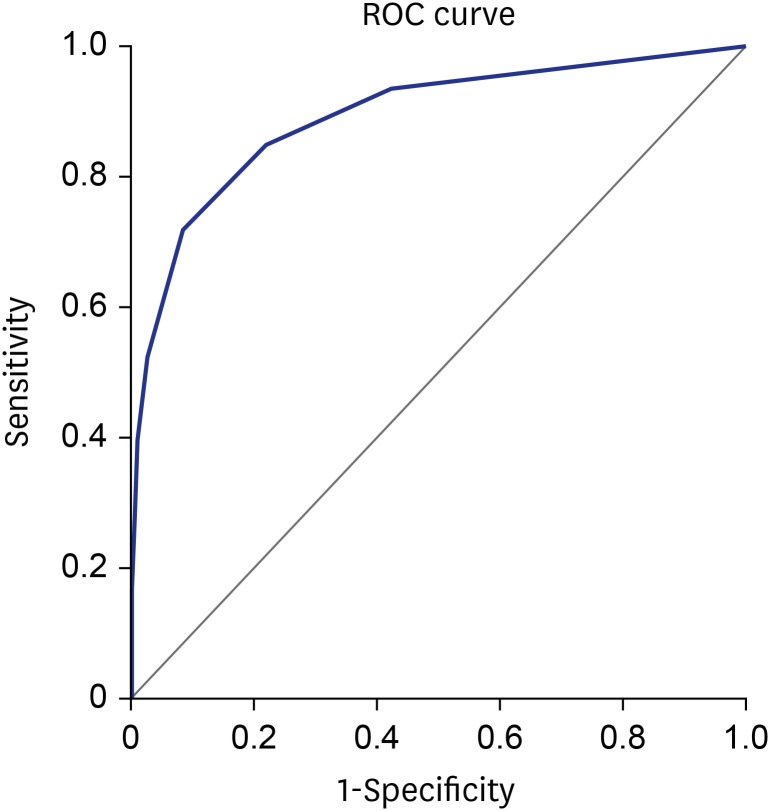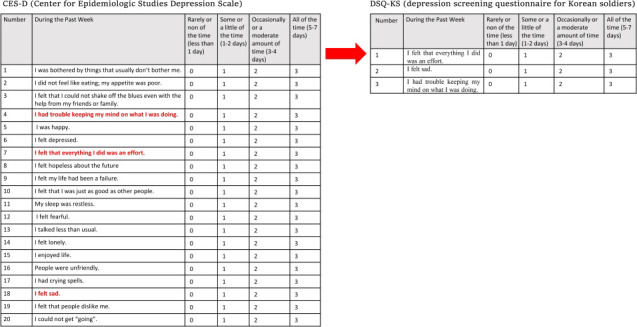1. World Health Organization. Depression and Other Common Mental Disorders: Global Health Estimates. Geneva, Switzerland: World Health Organization;2017.
2. Cho MJ, Seong SJ, Park JE, Chung IW, Lee YM, Bae A, et al. Prevalence and correlates of DSM-IV mental disorders in South Korean adults: the Korean Epidemiologic Catchment Area study 2011. Psychiatry Investig. 2015; 12(2):164–170.

3. Orsolini L, Latini R, Pompili M, Serafini G, Volpe U, Vellante F, et al. Understanding the complex of suicide in depression: from research to clinics. Psychiatry Investig. 2020; 17(3):207–221.

4. Jeon HJ. Epidemiologic studies on depression and suicide. J Korean Med Assoc. 2012; 55(4):322–328.

5. Beck A, Crain AL, Solberg LI, Unützer J, Glasgow RE, Maciosek MV, et al. Severity of depression and magnitude of productivity loss. Ann Fam Med. 2011; 9(4):305–311. PMID:
21747101.

6. Hong JP, Lee DW, Sim YJ, Kim YH. Awareness, attitude and impact of perceived depression in the workplace in Korea. J Korean Neuropsychiatr Assoc. 2015; 54(2):188–201.

7. Coretti S, Rumi F, Cicchetti A. The social cost of major depression: a systematic review. J Rev Eur Stud. 2019; 11(1):73.

8. Chang SM, Hong JP, Cho MJ. Economic burden of depression in South Korea. Soc Psychiatry Psychiatr Epidemiol. 2012; 47(5):683–689. PMID:
21526429.

9. Ministry of National Defense Republic of Korea. 2012 Defense White Paper. Seoul, Korea: Defense Policy Division, Policy Planning Bureau;2012.
10. Lim KS. Factor analysis related to soldier's suicide prevention program needs. J Mil Nurs Res. 2008; 26(2):162–177.
11. Cho MJ, Chang SM, Lee YM, Bae A, Ahn JH, Son J, et al. Prevalence of DSM-IV major mental disorders among Korean adults: a 2006 National Epidemiologic Survey (KECA-R). Asian J Psychiatr. 2010; 3(1):26–30. PMID:
23051134.

12. Ham BJ, Jeon HJ, Jang SM, Lee HW, Lee HJ, Shim EJ. Ministry of Defense Research Service Project Report-Investigation of the Prevalence of Mental Disorders (Including Acute Stress Disorder and Post-Traumatic Stress Disorder) in the Military. Seoul, Korea: Seoul National University College of Medicine;2007.
13. Sorenson SB, Rutter CM, Aneshensel CS. Depression in the community: an investigation into age of onset. J Consult Clin Psychol. 1991; 59(4):541–546. PMID:
1918558.

14. Cho MJ, Chang SM, Hahm BJ, Chung IW, Bae A, Lee YM, et al. Lifetime risk and age of onset distributions of psychiatric disorders: analysis of national sample survey in South Korea. Soc Psychiatry Psychiatr Epidemiol. 2012; 47(5):671–681. PMID:
21528435.

15. Radloff LS. The CES-D scale: a self-report depression scale for research in the general population. Appl Psychol Meas. 1977; 1(3):385–401.
16. Zhang W, O'Brien N, Forrest JI, Salters KA, Patterson TL, Montaner JS, et al. Validating a shortened depression scale (10 item CES-D) among HIV-positive people in British Columbia, Canada. PLoS One. 2012; 7(7):e40793. PMID:
22829885.

17. Cole JC, Rabin AS, Smith TL, Kaufman AS. Development and validation of a Rasch-derived CES-D short form. Psychol Assess. 2004; 16(4):360–372. PMID:
15584795.

18. Moullec G, Maïano C, Morin AJ, Monthuy-Blanc J, Rosello L, Ninot G. A very short visual analog form of the Center for Epidemiologic Studies Depression Scale (CES-D) for the idiographic measurement of depression. J Affect Disord. 2011; 128(3):220–234. PMID:
20609480.

19. Sheehan DV, Lecrubier Y, Sheehan KH, Amorim P, Janavs J, Weiller E, et al. The Mini-International Neuropsychiatric Interview (M.I.N.I.): the development and validation of a structured diagnostic psychiatric interview for DSM-IV and ICD-10. J Clin Psychiatry. 1998; 59(Suppl 20):22–33.
20. Yoo SW, Kim YS, Noh JS, Oh KS, Kim CH, NamKoong K, et al. Validity of Korean version of the mini-international neuropsychiatric interview. Anxiety Mood. 2006; 2(1):50–55.
21. Cho MJ, Kim KH. Use of the Center for Epidemiologic Studies Depression (CES-D) scale in Korea. J Nerv Ment Dis. 1998; 186(5):304–310. PMID:
9612448.

22. Wittchen HU. Reliability and validity studies of the WHO--Composite International Diagnostic Interview (CIDI): a critical review. J Psychiatr Res. 1994; 28(1):57–84. PMID:
8064641.

23. Cho MJ, Hahm BJ, Suh DW, Hong JP, Bae JN, Kim JK, et al. Development of a Korean version of the composite international diagnostic interview (K-CIDI). J Korean Neuropsychiatr Assoc. 2002; 41(1):123–137.
24. Koh KB, Park JK, Kim CH. Development of the stress response inventory. J Korean Neuropsychiatr Assoc. 2000; 39(4):707–719.
25. Choi SM, Kang TY, Woo JM. Development and validation of a modified form of the stress response inventory for workers. J Korean Neuropsychiatr Assoc. 2006; 45(6):541–553.
26. Patton JH, Stanford MS, Barratt ES. Factor structure of the Barratt Impulsiveness Scale. J Clin Psychol. 1995; 51(6):768–774. PMID:
8778124.

27. Lee HS. Impulsivity Test. Seoul, Korea: Korean Guidance;1992.
28. Lubben J, Gironda M. Centrality of social ties to the health and well-being of older adults. In : Berkman B, Harooytan L, editors. Social Work and Health Care in an Aging World: Informing Education, Policy, Practice, and Research. New York, NY, USA: Springer;2003. p. 319–350.
29. Bland JM, Altman DG. Cronbach's alpha. BMJ. 1997; 314(7080):572. PMID:
9055718.
30. Metz CE. Basic principles of ROC analysis. Semin Nucl Med. 1978; 8(4):283–298. PMID:
112681.

31. Altman DG, Bland JM. Diagnostic tests 2: predictive values. BMJ. 1994; 309(6947):102. PMID:
8038641.
32. Granö N, Keltikangas-Järvinen L, Kouvonen A, Virtanen M, Elovainio M, Vahtera J, et al. Impulsivity as a predictor of newly diagnosed depression. Scand J Psychol. 2007; 48(2):173–179. PMID:
17430370.

33. Paykel ES. Life events, social support and depression. Acta Psychiatr Scand Suppl. 1994; 377:50–58. PMID:
8053367.

34. American Psychiatric Association. Diagnostic and Statistical Manual of Mental Disorders: DSM-5. Washington, D.C., USA: American Psychiatric Association Publishing;2013.











 PDF
PDF Citation
Citation Print
Print




 XML Download
XML Download